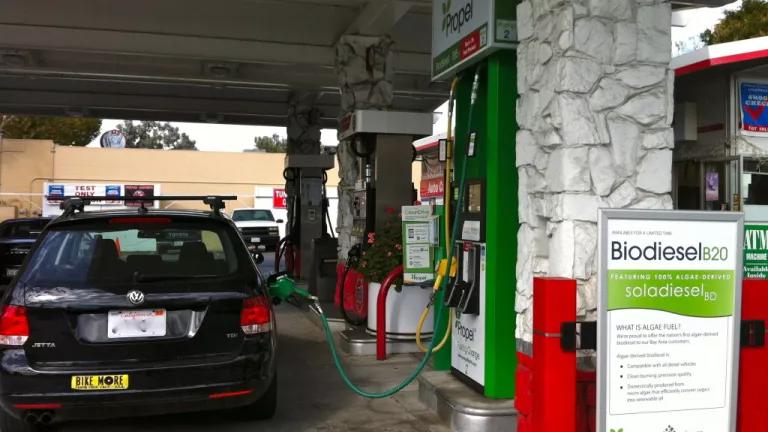California's Low Carbon Fuel Standard Could Triple Clean, Alternative Fuels Market By 2025

Governor Jerry Brown, in his fourth inaugural address last month, announced targets to halve the need for petroleum in California by 2030 as part of a broad plan to prevent climate change from becoming the defining legacy we pass on to our kids. In my last blog, I pointed out that California is already on track to meet half this target by 2030, thanks to existing clean transportation policies under the state's clean energy and climate law passed in 2006, known as AB32. While California's DNA is to dream big, we're also a state that's about leadership, innovation, and getting things done to protect the environment and reduce air pollution.
Now, one of the key measures under AB32, the Low Carbon Fuel Standard (LCFS), could help us get even closer to the target, according to a new report by Promotum, a fuels and chemicals technology consultancy. The report was commissioned by the Natural Resources Defense Council, the Environmental Defense Fund, and the Union of Concerned Scientists.
Taking one giant step forward
The LCFS requires the oil industry and fuel providers to reduce the carbon footprint of transportation fuels by 10% by 2020. The study, which systematically evaluated the ability of oil industry to meet the LCFS requirements, shows that not only can the industry handily meet the standard, but it can exceed the standard and hit a 15% reduction target by 2025. The result would be a tripling in cleaner alternative fuel use to 20% of the transportation energy mix, taking us one giant step closer to the Administration's goals.
While the oil industry continues to maintain the standard is out of their reach, the study comes on top a growing body of literature pointing to the ability to meet the LCFS requirements (see here, here, and here for a few). The report finds that, in large part, thanks to program's performance-based approach of not picking technology winners, a large number of clean fuel technologies will contribute to meeting the standard.
Algae-based biodiesel, produced by Solazyme being offered by Propel refueling stations. (Source: www.fuelinggrowth.org)
The oil industry should stop with the front groups and put their engineers to work
While the oil industry has spent a record $70 million in the state advancing its agenda since 2009, Californians and most legislators have largely rejected the oil industry's attacks on AB32 and its clean transportation policies. The oil industry tactics were recently unmasked by Bloomberg Businessweek as a "conspiracy to kill off California's climate law" through the creation of 15-plus front groups made "to look and sound like grassroot citizen-activists." They've now continued to take their front-group show on the road to other states like Oregon and Washington that are moving forward with their own clean fuel standards, with such misleading names like "Washington Consumers for a Sound Fuel Policy."
Ironically, today's new study shows that the LCFS is highly flexible and doesn't pick technology winners, allowing engineers from the clean fuels and petroleum industry alike to select the most cost-effective approach to reducing the carbon footprint of their fuels. The study finds the industry can meet a 15% by 2025 reduction target through (1) producing or blending in greater volumes of lower-carbon, alternative fuels, (2) reducing the carbon footprint of existing alternative fuels through improvements in production practices and switching to lower-carbon feedstocks, or (3) directly reducing the carbon footprint of petroleum-based fuels through use of energy efficiency, renewable energy, and other innovative technologies at refineries and crude oil production facilities.
The oil industry—which spent $200 billion on capital expenditures in oil and gas in North America in 2013 alone—has ample technological talent and resources at their disposal. For example, the oil industry is one of the largest commercial users of fossil natural gas in the state at both refineries and crude oil facilities. If solar thermal technologies, produced by companies such as Glasspoint and Brightsource, were used to displace 30% of the fossil natural gas used to produce steam at crude oil facilities in California, over 4 million tons of carbon pollution (MMT CO2e) could be avoided and help meet a fifth of standard. And that's just one technology.

Solar steam generation (Source: www.glasspoint.com)
Switching to even lower carbon feedstocks, such as biodiesel from recycled greases or ethanol from agricultural residues, are other strategies to reduce emissions. As my colleague, Jeremy Martin at Union of Concerned Scientists writes: "The question is no longer whether or not cellulosic biofuels will arrive; it's how big a part in the industry our country will play."

Abengoa's cellulosic biofuel plant began production last year in Hugoton, Kansas (Source: courtesy of Abengoa, appearing in National Geographic)
California's Next Leadership Opportunity
With Governor Brown's ambitious but eminently achievable plans for clean energy, and with the urgency of climate change now upon us, all eyes will be upon ARB to maintain a strong 2020 requirement for the LCFS and to greenlight preparations for more aggressive targets for 2030. On February 19, the state's Air Resources Board (ARB) will consider whether to greenlight the readoption of the standard, together with a number of enhancements, since the original program was adopted in 2009. Many clean fuel producers are gathering this week in Sacramento, at the Clean, Low Carbon Fuels Summit and the California Biodiesel Conference, to talk to policymakers and experts alike about the importance of strong, stable policies to expanding supplies of clean fuels and spurring greater investments.
Policymakers have an enormous opportunity over the coming weeks to send a clear message that California is moving forward with clean energy, and that the positive legacy we are leaving for the next generation will not be derailed.
